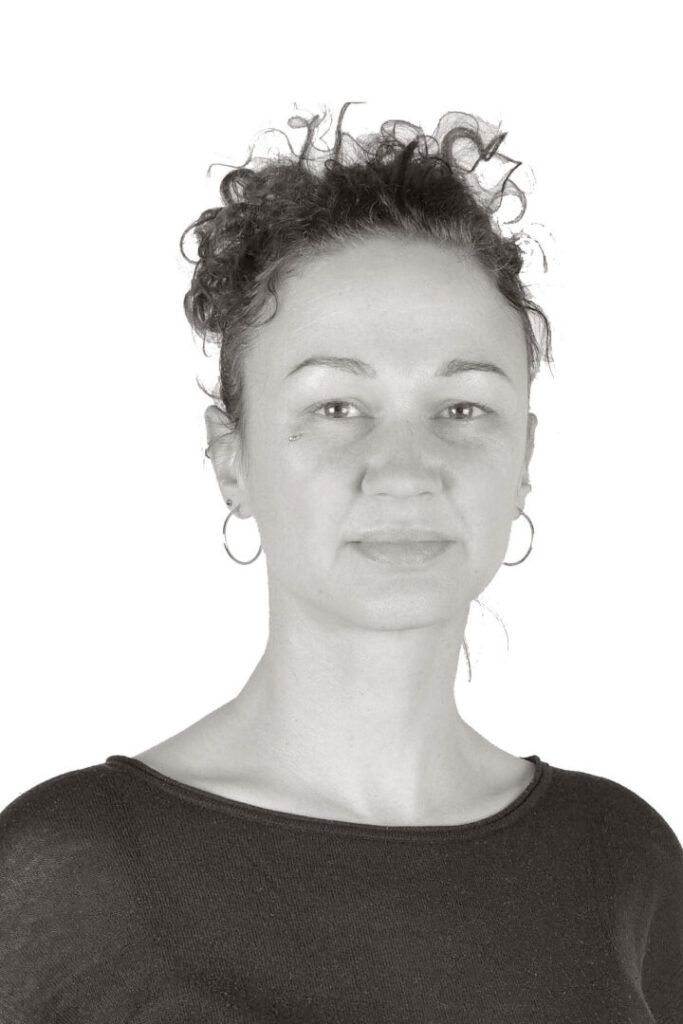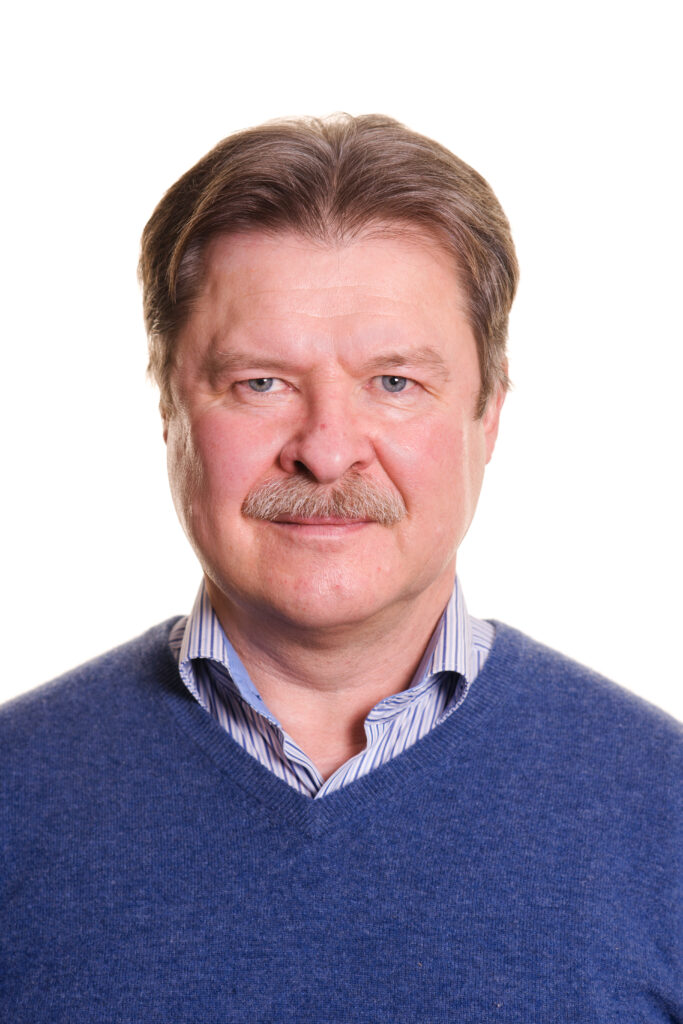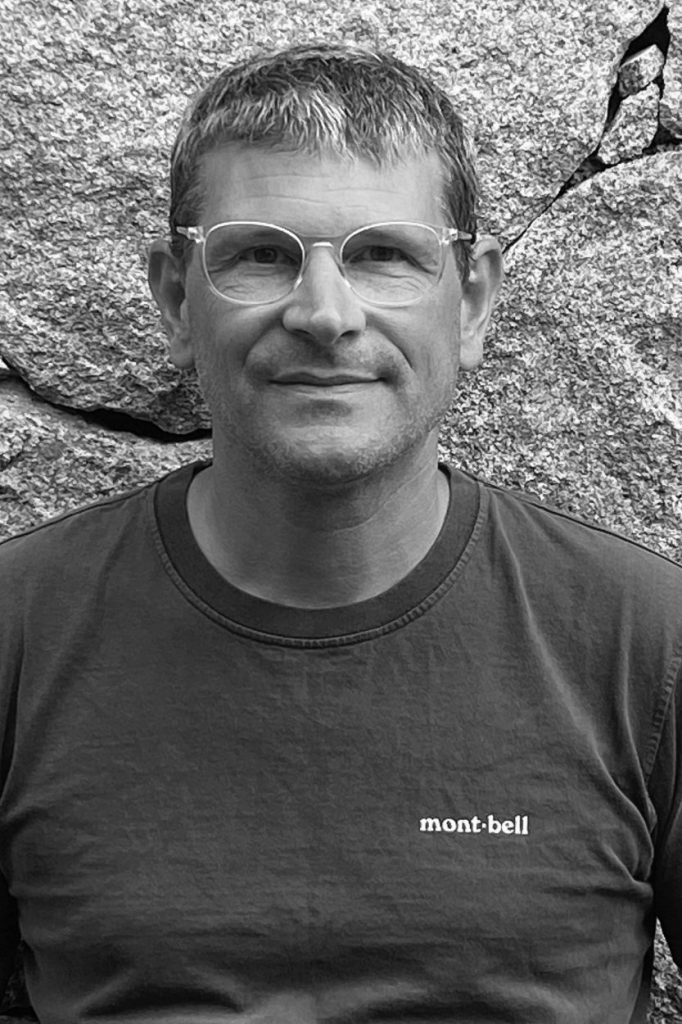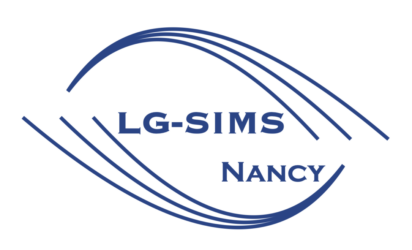
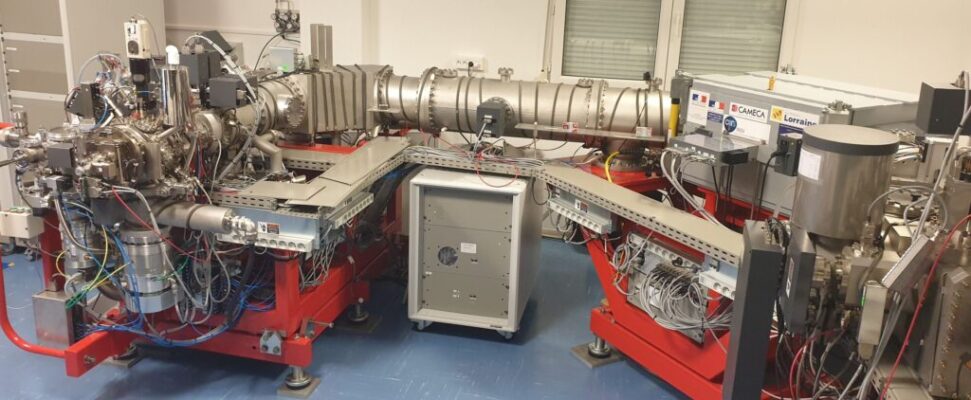
Responsable scientifique
Responsable technique
Personnel d'appui à la recherche
Chercheurs associés
La plateforme LG-SIMS-Nancy est spécialisée dans l’analyse isotopique et élémentaire in situ par microsonde ionique (ou SIMS pour Secondary Ions Mass Spectrometry) à haute résolution spatiale de la centaine de nanomètres à la dizaine de micromètres, à grande sensibilité et grande précision.
Les microsondes ioniques permettent de mesurer des concentrations élémentaires et des compositions isotopiques depuis la masse de l’hydrogène jusqu’à celle de l’uranium dans les solides : verres, minéraux, alliages, métaux, etc.
Les analyses les plus courantes sur nos instruments sont les analyses isotopiques des éléments stables traditionnels (H, C, N, O et S), non-traditionnels (Li, Be, B, Mg, Si, Cl, Ca, Fe, Cu, Pb), les datations U-Pb, Al-Mg, Mn-Cr, Rb-Sr et K-Ca, les teneurs en éléments traces (terres rares, halogènes) et en volatils (CO2, H2O).
La plateforme LG-SIMS-Nancy du CRPG, labélisée Instrument National de l’INSU et intégrée au réseau SIMS de l’IR RéGEF, est le seul laboratoire français à posséder ce type d’instrument et accueille à ce titre depuis 1998 l’ensemble des chercheurs de France qui en font la demande. Elle fait également partie de l’IR européenne Europlanet, et accueille à ce titre des chercheurs des laboratoires européens.
équipements
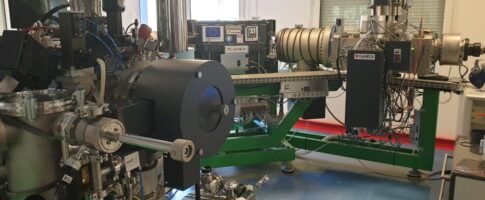
IMS 1270-E7 (LG-SIMS)
Historique :
Installé en 1996 au CRPG, son électronique et son système de vide ont été totalement remis à niveau en 2014. Un nouveau système cryogénique (piège froid pour l’amélioration du vide) et sas échantillons 6 places ont été ajouté en 2021. Depuis 2018, l’IMS 1270-E7 est équipée d’une source à oxygène de type Radio-féquence (RF) Hypérion. Ses performances sont à présent équivalentes à celles des sondes ioniques IMS 1280.
Particularité :
L’IMS 1270-E7 est équipée d’un système d’imagerie optique dernière génération permettant de faciliter le repérage de phases/minéraux micrométriques.
La cage de Faraday de la monocollection est équipée d’une carte de pré-amplification avec résistances 1012 ohm. Ces nouvelles cartes améliorent significativement le rapport signal sur bruit électronique lors des mesures, améliorant ainsi la précision analytique lorsque les taux de comptage sont bas (par exemple, ± 0.2‰ contre ± 0.6‰ avec une carte équipée d’une résistance 1011 Ω, pour un taux de comptage de 6×105 cps; Bouden et al., 2021).
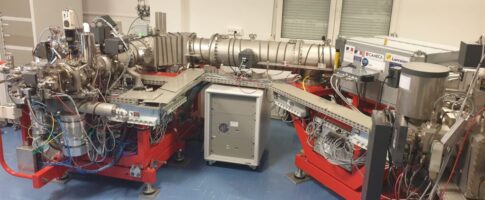
IMS 1280-HR2 (LG-SIMS)
Historique :
Installé en 2009 au CRPG. Depuis 2017, l’IMS 1280-HR2 est équipée d’une source à oxygène de type Radio-fréquence (RF) Hypérion.
Particularité :
Le secteur magnétique du spectromètre de masse de l’IMS 1280-HR2 possède une forme optimisée permettant d’atteindre de très hautes résolutions en masse (MRP jusqu’à 45 000).
Les cages de Faraday de la monocollection et de la multicollection sont équipées de carte de pré-amplification avec résistances 1012 ohm. Ces nouvelles cartes améliorent significativement le rapport signal sur bruit électronique lors des mesures, améliorant ainsi la précision analytique lorsque les taux de comptage sont bas (par exemple, ± 0.2‰ contre ± 0.6‰ avec une carte équipée d’une résistance 1011 Ω, pour un taux de comptage de 6×105 cps; Bouden et al., 2021).
membres
Conditions d’accès / Tarifs
La plateforme LG-SIMS-Nancy est un service national de l’INSU (SN-INSU/CNRS) qui accueille, en plus des projets des utilisateurs « internes » (chercheurs du CPRG et collaborateurs directs), les projets déposés par la communauté scientifique française dans le cadre du service national de l’INSU et des projets « externes » (réseau Europlanet, universitaires étrangers, industriels, privés).
Les demandes d’accès à la plateforme sont à effectuer via le formulaire à télécharger, à remplir et envoyer à l’adresse générique crpg-lgsims@univ-lorraine.fr. Pour une première demande ou des questions spécifiques, il est conseillé de s’adresser en amont au personnel de la plateforme (crpg-lgsims@univ-lorraine.fr).
Tous les utilisateurs devront accepter les conditions d’accès et de travail sur la plateforme et signer la charte d’utilisation de la plateforme (en version française ou version anglaise).
Tarifs :
Veuillez contacter les responsables de la plateforme pour une estimation détaillée du coût des mesures à venir.
Tarif unité sous tutelle CNRS : 558 € HT/ jour
Tarif académique hors CNRS : 1395 € HT/ jour
Tarif partenaires privés : 5308 € HT/ jour
Depuis le 1er janvier 2025, notre tarification est auditable certifiée par le CNRS et éligible pour l’ANR et l’ERC (décision disponible sur demande).
Préparation des échantillons pour une session d’analyse
Les mesures en sonde ionique nécessitent que les échantillons à analyser soient parfaitement plats et sans aspérités. Un mauvais état de surface peut nuire à la qualité des mesures. Les échantillons de roches et de minéraux analysés en SIMS sont généralement polis au micromètre ou quart de micromètre.
Plusieurs tailles/formats d’échantillons peuvent être adaptés aux portes échantillons des LG-SIMS, mais nous privilégions le format lame mince (25 mm x 30 mm) ou section circulaire de 1 pouce (2.54 cm) de ~1 à ~5 mm d’épaisseur.
Si possible, nous privilégions les montages en inclusion dans l’indium car cela permet d’obtenir de meilleures conditions de vide (dégazage rapide) et de conductibilité électrique. Les échantillons non conducteurs sont recouverts d’une fine couche d’or ou au carbone avant analyse (métallisation).
Nous avons aussi la possibilité d’adapter des lames minces et des formats uniques pour les cas particuliers. Dans ce cas, il est nécessaire d’en discuter avec l’équipe de la plateforme plusieurs semaines avant les analyses.
Plus généralement, il est vivement recommandé de prendre contact avec la plateforme LG-SIMS-Nancy (contact : crpg-lgsims@univ-lorraine.fr) pour discuter de la préparation des échantillons. Nous déterminerons ensemble le meilleur procédé de préparation afin que les échantillons répondent aux exigences et spécifications des mesures en sonde ionique.
Nous pouvons apporter un support technique et fournir le matériel nécessaire à la préparation des échantillons en amont des sessions de mesures. La préparation des échantillons reste néanmoins à la charge des utilisateurs (cf. charte des utilisateurs de la plateforme).
Publications récentes de la plateforme
2024
Asset, N., Chaussidon, M., Villeneuve, J., Charnoz, S., Koeberl, C., Wannier, M., & Robert, F. (2024). Condensation of fallout glasses in the Hiroshima nuclear fireball resulting in oxygen mass-independent fractionation. Earth and Planetary Science Letters, 626, 118473. https://doi.org/https://doi.org/10.1016/j.epsl.2023.118473
Barth, A., Portnyagin, M., Mironov, N., Holtz, F., Moussallam, Y., Rose-Koga, E. F., Rasmussen, D., Towbin, H., Gonnermann, H., Mutch, E. J. F., Rotolo, S. G., & Plank, T. (2024). Fast, furious, and gassy: Etna’s explosive eruption from the mantle. Earth and Planetary Science Letters, 643, 118864. https://doi.org/https://doi.org/10.1016/j.epsl.2024.118864
Dalou, C., Riguet, L., Villeneuve, J., Tissandier, L., Rigaudier, T., Cividini, D., Zollinger, J., & Paris, G. (2024). Synthesis and Characterization of Metallic (Fe-Ni, Fe-Ni-Si) Reference Materials for SIMS S/S Measurements. Geostandards and Geoanalytical Research, 48(4), 927–940. https://doi.org/https://doi.org/10.1111/ggr.12584
Deligny, C., Piralla, M., Villeneuve, J., Füri, E., & Marrocchi, Y. (2024). Potential Chronological Disturbance of the D’Orbigny Angrite Inferred from Discordant 26Al Ages. The Astrophysical Journal Letters, 975(1), L16. https://doi.org/10.3847/2041-8213/ad8654
Dürkefälden, A., Hauff, F., Hoernle, K., Portnyagin, M., Wartho, J.-A., Garbe-Schönberg, D., Gurenko, A., van den Bogaard, P., Kipf, A., & Gutjahr, M. (2024). Geochemical and temporal evolution of Indian MORB mantle revealed by the Investigator Ridge in the NE Indian Ocean. Gondwana Research, 134, 347–364. https://doi.org/https://doi.org/10.1016/j.gr.2024.07.016
Garcia Dobarganes-Bueno, J. E., Levresse, G., Estrada-Carmona, J., Nieto-Samaniego, A. F., Deloule, E., & Orozco-Esquivel, T. (2024). Chronological sequence of charcas igneous complex and their relationships with Zn–Pb–Ag mineralization events, San Luis Potosi state, Mexico. Journal of South American Earth Sciences, 138, 104814. https://doi.org/https://doi.org/10.1016/j.jsames.2024.104814
Genot, I., Angiboust, S., & Cartigny, P. (2024). Multiple sulfur isotopes evidence deep intra-slab transport of sulfate-rich fluids. Geochimica et Cosmochimica Acta, 377, 84–100. https://doi.org/https://doi.org/10.1016/j.gca.2024.05.025
Ghosh, S., Stünitz, H., Raimbourg, H., Précigout, J., Di Carlo, I., Heilbronner, R., & Piani, L. (2024). Importance of grain boundary processes for plasticity in the quartz-dominated crust: Implications for flow laws. Earth and Planetary Science Letters, 640, 118767. https://doi.org/https://doi.org/10.1016/j.epsl.2024.118767
Jansen, C. A., Burkhardt, C., Marrocchi, Y., Schneider, J. M., Wölfer, E., & Kleine, T. (2024). Condensate evolution in the solar nebula inferred from combined Cr, Ti, and O isotope analyses of amoeboid olivine aggregates. Earth and Planetary Science Letters, 627, 118567. https://doi.org/https://doi.org/10.1016/j.epsl.2024.118567
Jonker, G., van Maldeghem, F., van Ginneken, M., Krämer Ruggiu, L., & Goderis, S. (2024). Oxygen isotopic compositions of fresh rooftop micrometeorites from the Budel collection—Insights into the contemporary cosmic dust flux. Meteoritics \& Planetary Science, 59(6), 1236–1257. https://doi.org/https://doi.org/10.1111/maps.14145
Lee, H., Moussallam, Y., Rose Koga, E. F., Piani, L., Villeneuve, J., Bouden, N., Gurenko, A. A., Monteleone, B., & Gaetani, G. A. (2024). High–precision determination of carbon stable isotope in silicate glasses by secondary ion mass spectrometry: Evaluation of international reference materials. Chemical Geology, 670, 122428. https://doi.org/https://doi.org/10.1016/j.chemgeo.2024.122428
Lehn, I., & de Oliveira Vasconcelos, C. (2024). The role of organic matter in Brazilian Pre-Salt carbonates. The Depositional Record, 0, 1-15. https://doi.org/https://doi.org/10.1002/dep2.311
Mahlé, T., Marrocchi, Y., Neukampf, J., Villeneuve, J., & Jacquet, E. (2024). The last generation of nebular chondrules possibly sampled in the CH/CBb chondrite Isheyevo. Geochimica et Cosmochimica Acta, 385, 74–86. https://doi.org/https://doi.org/10.1016/j.gca.2024.08.027
Marrocchi, Y., Longeau, A., Goupil, R. L., Dijon, V., Pinto, G., Neukampf, J., Villeneuve, J., & Jacquet, E. (2024). Isotopic evolution of the inner solar system revealed by size-dependent oxygen isotopic variations in chondrules. Geochimica et Cosmochimica Acta, 371, 52–64. https://doi.org/https://doi.org/10.1016/j.gca.2024.03.001
Moussallam, Y., Towbin, W. H., Plank, T., Bureau, H., Khodja, H., Guan, Y., Ma, C., Baker, M. B., Stolper, E. M., Naab, F. U., Monteleone, B. D., Gaetani, G. A., Shimizu, K., Ushikubo, T., Lee, H. J., Ding, S., Shi, S., & Rose-Koga, E. F. (2024). ND70 Series Basaltic Glass Reference Materials for Volatile Element (HO, CO, S, Cl, F) Measurement and the C Ionisation Efficiency Suppression Effect of Water in Silicate Glasses in SIMS. Geostandards and Geoanalytical Research, 48(3), 637–660. https://doi.org/https://doi.org/10.1111/ggr.12572
Portnyagin, M., Dürkefälden, A., Hauff, F., Gurenko, A., Frick, D. A., Garbe-Schönberg, D., & Hoernle, K. (2024). A distinct type of MORB formed by two-stage melting of a hybrid mantle during Gondwana breakup. Earth and Planetary Science Letters, 647, 119021. https://doi.org/https://doi.org/10.1016/j.epsl.2024.119021
Rollion-Bard, C., Jurikova, H., & Henkel, D. (2024). High-resolution carbon and oxygen isotopic compositions of cultured brachiopods: Effect of pH, temperature and growth. Chemical Geology, 659, 122132. https://doi.org/https://doi.org/10.1016/j.chemgeo.2024.122132
Sun, Y., Jiao, Y., Cuney, M., Wu, L., Mercadier, J., Rong, H., Liu, Y., & Tao, Z. (2024). Sulfur isotope and trace element constraints on the conditions of pyrite formation from the Diantou-Shuanglong sandstone-hosted uranium deposit, Ordos Basin, China: Implications for uranium mineralization. Ore Geology Reviews, 165, 105921. https://doi.org/https://doi.org/10.1016/j.oregeorev.2024.105921
van Gerve, T. D., Neave, D. A., Wieser, P., Lamadrid, H., Hulsbosch, N., & Namur, O. (2024). The Origin and Differentiation of CO2-Rich Primary Melts in Ocean Island Volcanoes: Integrating 3D X-Ray Tomography with Chemical Microanalysis of Olivine-Hosted Melt Inclusions from Pico (Azores). Journal of Petrology, 65(2), egae006. https://doi.org/10.1093/petrology/egae006
van Gerve, T. D., Neave, D. A., Wieser, P., Lamadrid, H., Hulsbosch, N., Namur, O., Marrocchi, Y., Longeau, A., Goupil, R. L., Dijon, V., Pinto, G., Neukampf, J., Villeneuve, J., Jacquet, E., Dürkefälden, A., Hauff, F., Hoernle, K., Portnyagin, M., Wartho, J.-A., … Plank, T. (2024). Fast, furious, and gassy: Etna’s explosive eruption from the mantle. Gondwana Research, 65(2), 52–64. https://doi.org/https://doi.org/10.1016/j.epsl.2024.118864
van Ginneken, M., Harvey, R. P., Goderis, S., Artemieva, N., Boslough, M., Maeda, R., Gattacceca, J., Folco, L., Yamaguchi, A., Sonzogni, C., & Wozniakiewicz, P. (2024a). The identification of airbursts in the past: Insights from the BIT-58 layer. Earth and Planetary Science Letters, 627, 118562. https://doi.org/https://doi.org/10.1016/j.epsl.2023.118562
van Ginneken, M., Harvey, R. P., Goderis, S., Artemieva, N., Boslough, M., Maeda, R., Gattacceca, J., Folco, L., Yamaguchi, A., Sonzogni, C., & Wozniakiewicz, P. (2024b). The identification of airbursts in the past: Insights from the BIT-58 layer. Earth and Planetary Science Letters, 627, 118562. https://doi.org/https://doi.org/10.1016/j.epsl.2023.118562
Van Maldeghem, F., Maeda, R., Soens, B., Suttle, M. D., Ruggiu, L. K., Cordier, C., Yamaguchi, A., Schmitz, B., Claeys, P., Folco, L., & Goderis, S. (2024). Chrome-rich spinels in micrometeorites from modern Antarctic sedimentary deposits. Earth and Planetary Science Letters, 641, 118837. https://doi.org/https://doi.org/10.1016/j.epsl.2024.118837
2023
Bilau A., Bienveignant D., Rolland Y., Schwartz S., Godeau N., Guihou A., Deschamps P., Mangenot X., Brigaud B., Boschetti L., Dumont T. (2023). The Tertiary structuration of the Western Subalpine foreland deciphered by calcite-filled faults and veins. Earth Sci. Rev., 236, 104270. https://doi.org/10.1016/j.earscirev.2022.104270.
Charrieau L. M., Rollion-Bard C., Terbrueggen A., Wilson D. J., Pogge von Strandmann P. A. E., Misra S., Bijma J. (2023). Controls on Lithium Incorporation and Isotopic Fractionation in Large Benthic Foraminifera. Minerals, 13, 127. https://doi.org/10.3390/min13010127.
Corre M., Brunet F., Schwartz S., Gautheron C., Agranier A., Lesimple S. (2023). Quaternary low-temperature serpentinization and carbonation in the New Caledonia ophiolite. Scientific Reports, 13, #19413. https://doi.org/10.1038/s41598-023-46691-y.
Decrée S., Deloule E., Barros R., Mercadier J., Höhn S., Peiffert C., Baele J. P. M. (2023). Processes controlling Rare Earth Element distribution in sedimentary apatite: Insights from spectroscopy, in-situ geochemistry and O and Sr isotope composition.. Sedimentology. https://doi.org/10.1111/sed.13160.
Deligny C., Füri E., Deloule E., Peslier A. H., Faure F., Marrocchi Y. (2023). Origin of nitrogen on Mars: First in situ N isotope analyses of martian meteorites.. Geochim. Cosmochim. Acta., 344, 134-145. https://doi.org/10.1016/j.gca.2023.01.017.
Esposito R., Redi D., Danyushevsky L. V., Gurenko A., De Vivo B., Manning C. E., Bodnar R. J., Steele-Macinnis M., Frezzotti M.-L. (2023). Constraining the volatile evolution of mafic melts at Mt. Somma–Vesuvius, Italy, based on the composition of reheated melt inclusions and their olivine hosts. Europ. J. Mineral., 35, 921-948. https://doi.org/10.5194/ejm-35-921-2023.
Lotout C., Indares A., Vervoort J., Deloule E. (2023). High-P metamorphism in the Mesoproterozoic: Petrochronological insights from the Grenville Province. Precamb. Res., 399, 107208. https://doi.org/10.1016/j.precamres.2023.107208.
Marrocchi Y., Jacquet E., Neukampf J.,Villeneuve J., Zolensky M. (2023). For whom Bells tolls: Reclassifying Bells among CR chondrites and implications for the formation conditions of CR parent bodies. Meteor. Planet. Sci., 58, 195-206. https://doi.org/10.1111/maps.13947.
Marrocchi Y., Rigaudier T., Piralla M., Piani L. (2023). Hydrogen isotopic evidence for nebular pre-hydration and the limited role of parent-body processes in CM chondrites. Earth. Planet. Sci. Lett., 611, 118151. https://doi.org/10.1016/j.epsl.2023.118151.
Melfou M., Richard A., Tarantola A., Villeneuve J., Carr P., Peiffert C., Mercadier J., Dean B., Drejing-Carroll D. (2023). Tracking the origin of metasomatic and ore-forming fluids in IOCG deposits through apatite geochemistry (Nautanen North deposit, Norrbotten, Sweden). Lithos, 438-439, 106995. https://doi.org/10.1016/j.lithos.2022.106995.
Mourey A. J., France L., Ildefonse B., Gurenko A., Laporte D. (2023). Genesis of carbonatite at Oldoinyo Lengai (Tanzania) from olivine nephelinite: protracted melt evolution and reactive porous flow in deep crustal mushes. J. Petrol., egad084. https://doi.org/10.1093/petrology/egad084.
Moussalam Y., Georgeais G., Rose-Koga E. F., Koga K. T., Hartley M. E., Scaillet B., Oppenheimer C., peters N. (2023). CO2 undersaturated melt inclusions from the South West Indian ridge record surprisingly uniform redox conditions. Geochem. Geophys. Geosyst., 24, e2023GC011235. https://doi.org/10.1029/2023GC011235.
Neukampf J., Ellis B., Magna T, Laurent O., Marrocchi Y. (2023). Partitioning and isotopic fractionation of Li between mineral phases and alkaline to calc-alkaline melts of explosive and effusive eruptions. Chem. Geol., 636, 121628. https://doi.org/10.1016/j.chemgeo.2023.121628.
Ougadire M., Askkour F., Favier A., Ousbih M., Ikenne M., Geraud Y. (2023). Petrogenesis of the late Ediacaran A-type granites of the western part of the Moroccan Anti-Atlas belt: Insights from U–Pb dating, geochemistry and Sr–Nd isotopes of the Sidi El Houssein, Tafraout and Taourgha intrusions. J. Afr. Earth Sci., 203, 104947. https://doi.org/10.1016/j.jafrearsci.2023.104947.
Piani L., et al. (87 authors) (2023). Hydrogen Isotopic Composition of Hydrous Minerals in Asteroid Ryugu. The Astrophys. J. Lett., 946, L43. https://doi.org/10.3847/2041-8213/acc393.
Piralla M., Villeneuve J., Schnuriger N., Bekaert D. V., Marrocchi Y. (2023). A unified chronology of dust formation in the early solar system. Icarus, 394, 115427. https://doi.org/10.1016/j.icarus.115427.
Prabha-Mohan, S., Koga, K.T., Mathieu, A., Pointud, F., Narvaez, D.F., One-atmosphere high-temperature CO–CO2–SO2 gas-mixing furnace: design, operation, and applications. Europ. J.Mineral., 35, 321-331. https://doi:10.5194/ejm-35-321-2023.
Thomassin D., Piani L., Villeneuve J., Caumon M.-C., Bouden N., Marrocchi Y. (2023). The high-temperature origin of hydrogen in enstatite chondrite chondrules and implications for the origin of terrestrial water. Earth. Planet. Sci. Lett., 616, 118225. https://doi.org/10.1016/j.epsl.2023.118225.
Vésin C., Rubato D., Pettke T., Deloule E. (2023). Multistage hydration during oceanic serpentinisation revealed by in situ oxygen isotope and trace element analyses. Geochim.. Cosmochim. Acta., 355, 13-31. https://doi.org/10.1016/j.gca.2023.06.032.
Wagner C., Villeneuve J., Boudouma O., Rividi N., Orberger B., Nabatian G., Honarmand M., Monsef I. (2023). In Situ Trace Element and Fe-O Isotope Studies on Magnetite of the Iron-Oxide Ores from the Takab Region, North Western Iran: Implications for Ore Genesis. Minerals. 13, 774. https://doi.org/10.3390/min13060774.
2022
Abidi R., Slim-Shimi N., Marignac C., Somarin A.K., Renac C., Deloule E., Hatira N., Gasquet D. (2022). The microbial controls on the deposition of Pb-Zn minerals in carbonate-hosted Tunisian ore deposits, Resource Geology, 72
Azzam F., Blaise T., Patrier P., Abd Elmola A., Beaufort D., Portier E., Brigaud B., Barbarand J., Clerc S. (2022). Diagenesis and reservoir quality evolution of the Lower Cretaceous turbidite sandstones of the Agat Formation (Norwegian North Sea): Impact of clay grain coating and carbonate cement. Marine Petrol. Geol., 142, 105768. https://doi.org/10.1016/j.marpetgeo.2022.105768
Borisova A. Y., Nédélec A., Zagrtdenov N. R., Toplis M. J., Bohrson W. A., Safonov O. G., Bindeman I. N., Melnik O. E., Pokrovski G. S., Ceuleneer G., Jochum K. P., Stoll B., Weis U., Bychlkov A. Y., Gurenko A. A. (2022). Hadean zircon formed due to hydrated ultramafic protocrust melting. Geology. 50, 300-304. https://doi.org/10.1130/G49354.1.
Bouilhol P., Debret B., Inglis E. C., Warembourg M., Grocolas T., Rigaudier T., Villeneuve J., Burton K. W. (2022). Decoupling of inorganic and organic carbon during slab mantle devolatilisation. Nature Com., 13, 308. https://doi.org/10.1038/s41467-022-27970-0.
Dallai L., Bianchini G., Avanzinelli R., Deloule E., Natali C., Gaeta M., Cavallo A., Conticelli S. (2022). Quartz-bearing rhyolitic melts in the Earth’s mantle. Nature Comm., 13:7765. https://doi.org/10.1038/s41467-022-35382-3.
Dalou C., Deligny C., Füri E. (2022). Nitrogen isotope fractionation during magma ocean degassing: tracing the composition of early Earth’s atmosphere. Geochem. Persp. Lett., 20, 27-31. https://doi.org/10.7185/geochemlet.2204.
Feignon J. G., Cluzel N., Schiavi F., Moune S., Roche O., Clavero J., Schiano P., Auxerre M. (2022). High CO2 content in magmas of the explosive andesitic Enco eruption of Mocho-Choshuenco volcano (Chile). Bull. Volc,. 84, #40. https://doi.org/10.1007/s00445-022-01550-y.
Ferrando C., Tribuzio R., Lissenberg C. J., France L., McLeod C. J., Basch V., Villeneuve J., Deloule E., Sanfilippo A. (2022). Brown Amphibole as Tracer of Tectono-Magmatic Evolution of the Atlantis Bank Oceanic Core Complex (IODP Hole U1473A). J. Petrol,. 63, 1-27. https://doi.org/10.1093/petrology/egac089.
Kawaguchi M., Koga K. T., Rose-Koga E., Shimizu K., Ushikubo T., Yoshiasa A. (2022). Sulfur isotope and trace elemment systematics in arc magmas: seeing through the degassing via a melt inclusion study of Kyushu Island volcanoes, Japan. J. Petrol., 63, egac061. https://doi.org/10.1093/petrology/egac061.
Lampe S., Soens B., Chernonozhkin S. M., Gonz.lez de Vega C., van Ginneken M., Van Maldeghem F., Vanhaecke F., Glass B. P., Franchi I. A., Terryn H., Debaille V., Claeys Ph., Goderis S. (2022). Decoupling of chemical and isotope fractionation processes during atmospheric heating of micrometeorites. Geochim Cosmochim Acta, 324, 221-239. https://doi.org/10.1016/j.gca.2022.02.008.
Liu J., Tao C., Zhou J., Shimizu K., Li W., Liang J., Liao S., Kuritani T., Deloule E., Ushikudo T., Nakagawa M., Yang W., Zhang G., Liu Y., Zhu C., Sun H., Zhou J. (2022). Water enrichment in the mid-ocean ridge by recycling of mantle wedge residue. Earth. Planet. Sci. Lett, 584, 117455. https://doi.org/10.1016/j.epsl.2022.117455.
Lorenzon S., Novella D., Nimis P., Jacobsen S. D., Thomassot E., Pamato M. G., Prosperi L., Lorenzetti A., Alvaro M., Brenker F., Salvadego F., Nestola F. (2022). Ringwoodite and zirconia inclusions indicate downward travel of super-deep diamonds. Geology. https://doi.org/10.1130/G50111.1.
Mamadou M.M., Cathelineau M., Deloule E., Reisberg L., Cardon O., Brouand M. (2022) The Tim Mersoï Basin uranium deposits (Northern Niger): geochronology and genetic model. Ore Geol. Rev., 145, 104905. DOI: 10.1016/j.oregeorev.2022.104905.
Marrocchi Y., Piralla M., Regnault M., Batanova V., Villeneuve J., Jacquet E. (2022). Isotopic evidence for two chondrule generations in CR chondrites and their relationships to other carbonaceous chondrites. Earth. Planet. Sci. Lett, 593, 117683. https://doi.org/10.1016/j.epsl.2022.117683.
Morin G. L. F., Marrocchi Y., Villeneuve J., Jacquet E. (2022). 16O-rich anhydrous silicates in CI chondrites: Implications for the nature and dynamics of dust in the solar accretion disk. Geochim. Cosmochim. Acta, 332, 203-219. https://doi.org/10.1016/j.gca.2022.
Radu I. B., Moine B. N., Bolfan-Casanova N., Ionov D. A., Devidal J.-L., Deloule E., Korsakov A. V., Golovin A. V., Oleinikov O. B., Cottin J. Y. (2022). Zoisite in cratonic eclogite xenoliths – Implications for water in the upper mantle. Lithos. 418-419, 106681. https://doi.org/10.1016/j.lithos.2022.106681.
Regnault M., Marrocchi Y., Piralla M., Villeneuve J., Batanova V., Schnuriger N., Jacquet E. (2022). Oxygen isotope systematics of chondrules in Rumuruti chondrites: Formation conditions and genetic link with ordinary chondrites. Meteor. Planet. Sci., 57, 122-135. https://doi.org/10.1111/maps.13778.
Rudraswami N.G., Suttle M.D., Marrocchi Y., Taylor S., Villeneuve J. (2022) In-situ O-isotope analysis of relict spinel and forsterite in small (<200µm) Antarctic micrometeorites – samples of chondrules & CAIs, primarily from carbonaceous chondrites. Geochim. Cosmochim. Acta, 325, 1-24, https://doi.org/10.1016/j.gca.2022.03.015.
Schnuriger N., Cartier C., Villeneuve J., Batanova V., Regnault M., Marrocchi Y. (2022). Oxygen isotope systematics of chondrules in Rumuruti chondrites: Formation conditions and genetic link with ordinary chondrites. Meteor. Planet. Sci., 57, 1018-1037. https://doi.org/10.1111/maps.13802.
Soens B., Chernonozhkin S. M., González de Vega C., Vanhaecke F., van Ginneken M., Claeys Ph., and Goderis S. (2022). Characterization of achondritic cosmic spherules from the Wider.efjellet micrometeorite collection (S.r Rondane Mountains, East Antarctica). Geochim. Cosmochim. Acta, 325, 106-128. https://doi.org/10.1016/j.gca.2022.03.029.
Thiry M., Franke C., Yao K. F. E., Szuszkiewicz A., Fàbrega C., Jeleńska M., Kądziałko-Hofmokl M., Gurenko A., Parcerisa D., Sobczyk A., Turniak K., Aleksandrowski P. (2022) Albitization and oxidation of Variscan granitoid rocks related to the post-Variscan paleosurface in the Sudetes (Bohemian Massif, SW Poland). Intern. J. Earth Sci. DOI: 10.1007/s00531-022-02274-2.
Vézinet A., Thomassot E., Luo Y., Pearson D. G., Stern R. A., Sarkar C. (2022). Zircon geochronology and Hf–O isotopes of the Nulliak supracrustal assemblage (Saglek Block–Canada): Constraints on deposition age and setting, metamorphic age and environments of zircon crystallization. Precamb. Res., 379, 106789. https:// doi.org/10.1016/j.precamres.2022.106789.
Witt C., Poujol M., Chiaradia M., Villagomez D., Seyler M., Averbuch O., Bouden N. (2022). Geodynamic controls in the southernmost Northern Andes magmatic arc: Trace elements and Hf-O isotopic systematics in forearc detrital zircon . GSA Bull., https://doi.10.1130/B36510.1.
Xu Q.H., Wang L., Liu J., Deloule E., Hanski E., Gu X. Y., Chen H., Xia Q. K. (2022). Linking the Jehol Biota evolution to the Early Cretaceous volcanism during the North China craton destruction: Insights from F, Cl, S, and P. J. Geophys. Res.: Solid Earth, 127, e2022JB024388. https://doi.org/10.1029/2022JB024388.
Zelenski M., Kamenetsky V. S., Nekrylov N., Kontonikas-Charos A. (2022). High Sulfur in Primitive Arc Magmas, Its Origin and Implications. Minerals, 12, 37. https://doi.org/10.3390/min12010037.
2021
Gress M. U., Timmerman S., Chinn I. L., Koornneef J. M., Thomassot E., van der Valk E. A. S., van Zuilen K., Bouden N., Davies G. R. (2021). Two billion years of episodic and simultaneous websteritic and eclogitic diamond formation beneath the Orapa kimberlite cluster, Botswana. Contrib. Mineral. Petrol. 176:54. https://doi. org/10.1007/s00410-021-01802-8
Lenoir L., Blaise T., Somogyi A., Brigaud B., Barbarand J., Boukari C., Nouet J., Brézard-Oudot A., Pagel M. (2021). Uranium incorporation in fluorite and exploration of U-Pb dating. Geochronology, 3, 199-227.
Richter F., Saper L. M., Villeneuve J., Chaussidon M., Watson E. B., Davis A. M., Mendybaev R. A., Simon S. B. (2021). Reassessing the thermal history of martian meteorite Shergotty and Apollo mare basalt 15555 using kinetic isotope fractionation of zoned minerals. Geochim. Cosmochim. Acta, 295, 265-285. https:// doi.org/10.1016/j.gca.2020.11.002
Rutman P., Hoareau G., Kluska J.- M., Lejay A., Fialips C., Gelin F., Aubourg C., Hernandez-Bilbao E. (2021). Diagenesis and alteration of subsurface volcanic ash beds of the Vaca Muerta Formation, Argentina. Marine Petrol. Geol., 132. #105220.
Van Ginneken M., Goderis S., Artemieva N., Debaille V., Decrée S., Harvey P., Huwig K. A., Hecht L., Yang S., Kaufmann F. E. D., Soens B., Humayun M., Van Maldeghem F., Genge M. J., Claeys P. (2021). A large meteoritic event over Antarctica ca. 430 ka ago inferred from chondritic spherules from the Sør Rondane Mountains. Science Adv., 7/14. https://doi.org/10.1126/sciadv.abc1008










